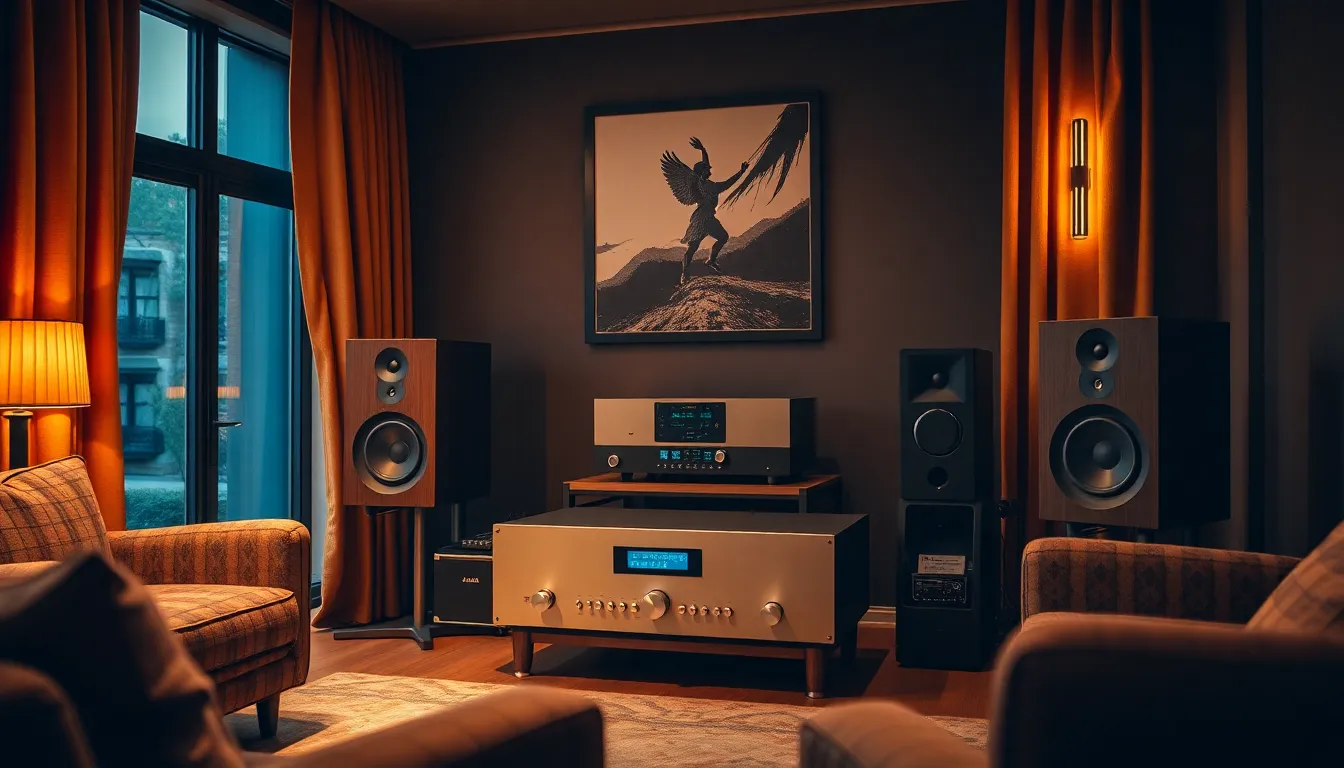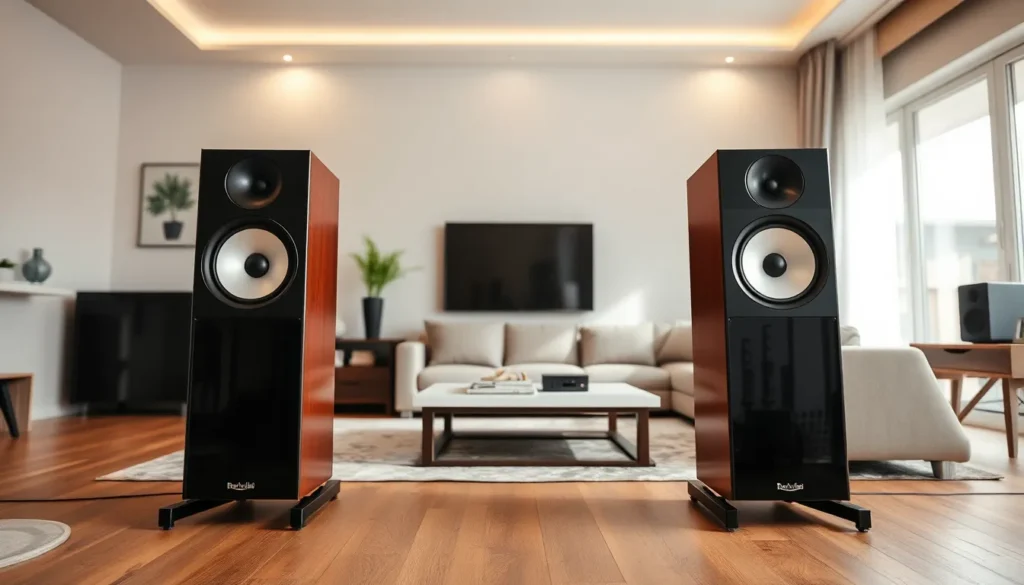Table of Contents
ToggleImagine sinking into your favorite chair, a glass of something delightful in hand, as the sweet sound of your favorite artist fills the room. That’s the magic of high fidelity audio. It’s not just about hearing music; it’s about experiencing it in all its rich, vibrant glory. Gone are the days of tinny speakers and muffled sounds. High fidelity audio elevates listening to an art form, making every note and nuance come alive.
What Is High Fidelity Audio?
High fidelity audio refers to sound reproduction that aims to ensure an accurate representation of the original recording. This clarity allows for an immersive listening experience.
Key Characteristics
Key characteristics include low distortion levels, wide frequency response, and high dynamic range. Low distortion ensures sound quality is as close to the original recording as possible. Wide frequency response captures the full spectrum of audible sounds, from deep bass to crisp treble. High dynamic range allows listeners to experience the nuances in volume without losing detail in quieter passages.
Importance in Music Quality
Importance in music quality cannot be overstated. High fidelity audio enables listeners to appreciate every instrument and vocal nuance in a piece. It reveals subtle details often lost in lower quality formats. Enhanced clarity leads to a richer, more engaging listening experience. Improved sound quality contributes to a deeper emotional connection to the music.
Benefits of High Fidelity Audio

High fidelity audio provides numerous advantages that significantly enhance the music experience. It offers listeners a deeper connection to their favorite tracks and a more immersive soundscape.
Enhanced Listening Experience
Enhanced listening experience stands out as a primary benefit of high fidelity audio. Clarity in sound reproduction allows details to emerge, such as instrumental nuances and vocal subtleties. Listeners notice the richness in sound, creating a more engaging atmosphere. Depth and texture in music create an emotional connection, making listeners feel as if they are part of the performance. High fidelity audio systems reproduce sound with low distortion, ensuring that each note resonates fully. This level of audio fidelity transforms how music is enjoyed, leading to a more satisfying and enriching experience.
Impact on Music Production
Impact on music production reflects the importance of high fidelity audio in the industry. Producers rely on high quality audio standards to capture the essence of the original performance. Higher fidelity allows for greater precision in mixing and mastering, ensuring that every sound element blends harmoniously. Artists benefit from clear sound reproduction, facilitating creative decisions during the recording process. Quality audio reinforces the emotional delivery of songs, crucial for connecting with audiences. Finally, high fidelity audio adheres to industry benchmarks, ensuring that the final product meets listeners’ expectations.
Popular High Fidelity Audio Formats
Various formats contribute to the high fidelity audio experience, allowing listeners to enjoy music in its richest form. Two widely recognized formats are vinyl records and lossless digital formats.
Vinyl Records
Vinyl records offer a unique auditory experience cherished by many audiophiles. The analog nature of vinyl captures sound waves continuously, enhancing warmth and depth in music reproduction. Many listeners appreciate the tactile interaction and visual appeal of physical albums, which often feature intricate artwork. Records typically produce a frequency response ranging from 20 Hz to 20 kHz, closely resembling human hearing capabilities. Additionally, the characteristic pops and crackles of vinyl add to its charm, creating a nostalgic atmosphere for music lovers.
Lossless Digital Formats
Lossless digital formats provide high-quality sound without losing any data during compression. Formats such as FLAC (Free Lossless Audio Codec) and ALAC (Apple Lossless Audio Codec) retain all audio details, ensuring an authentic listening experience. These files often maintain high dynamic range, allowing subtle instrumentation to shine. Users can easily store and access these formats on various devices, combining convenience with sound quality. Popular streaming services now offer lossless audio options, appealing to listeners seeking fidelity in their digital music libraries.
Essential Equipment for High Fidelity Audio
Selecting the right equipment is crucial for achieving high fidelity audio. Essential components include speakers and amplifiers that enhance sound quality.
Speakers
Speakers play a vital role in delivering high fidelity sound. They reproduce audio with clarity and precision, allowing listeners to appreciate every detail in the music. To achieve accurate sound reproduction, full-range speakers with a balanced frequency response are highly recommended. Brands like Bowers & Wilkins and KEF consistently receive praise for their performance. Consider bookshelf or floor-standing options based on space and preference. Equipping speakers with quality cables can further enhance the listening experience, minimizing signal loss. The placement of speakers in a room influences soundstage and imaging, making strategic positioning key for optimal performance.
Amplifiers
Amplifiers are essential for powering speakers and ensuring sound fidelity. They increase audio signals for improved clarity and dynamic range. A reliable amplifier can significantly enhance the listening experience, especially when paired with high-quality speakers. Solid-state and tube amplifiers are popular choices, each offering unique sonic characteristics. Tube amplifiers tend to produce warmer tones, while solid-state options deliver accurate sound and higher power output. Investing in an amplifier with sufficient wattage will prevent distortion at higher volumes. Look for models that boast low total harmonic distortion for optimal performance. Ultimately, selecting the right amplifier contributes to achieving the immersive audio experience high fidelity listeners seek.
The Future of High Fidelity Audio
High fidelity audio continues to evolve, driven by trends and innovations that shape the listening experience. Manufacturers focus on advancing technology to deliver unparalleled sound quality.
Trends and Innovations
New technologies are reshaping high fidelity audio. Wireless audio systems now offer convenience without sacrificing sound quality. Advances in digital-to-analog converters enhance clarity and detail in music playback. Increasing interest in spatial audio creates immersive environments for listeners. Cutting-edge formats such as Dolby Atmos and Sony 360 Reality Audio allow for multi-dimensional sound experiences. Additionally, artificial intelligence tools optimize audio settings based on individual preferences. Innovations in materials, like improved speaker cones and acoustic enclosures, further elevate performance.
The Role of Streaming Services
Streaming services play a crucial role in high fidelity audio’s future. Many platforms now provide lossless audio options catering to audiophiles. Tidal, Amazon Music HD, and Qobuz offer high-resolution streaming that captures the nuances of original recordings. Users can access extensive catalogs without loss of quality. Integration with smart speakers and audio devices facilitates easy listening experiences. Enhanced user interfaces guide listeners toward high quality content tailored to their preferences. These services contribute to a growing demand for high fidelity formats, driving artists and producers to prioritize audio quality in their work.
High fidelity audio represents a significant leap in how music is experienced. With its ability to deliver unparalleled clarity and depth, it transforms ordinary listening into a captivating journey. The evolution of technology and the rise of lossless formats ensure that audiophiles can enjoy music as it was intended.
Investing in quality equipment and embracing advancements in audio technology can elevate the listening experience to new heights. As the industry continues to innovate, the future of high fidelity audio promises even more immersive experiences, making it an exciting time for music lovers everywhere.







